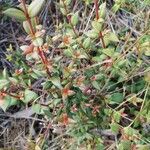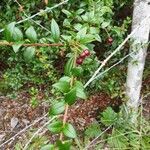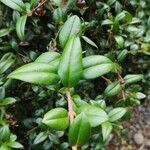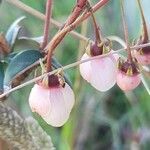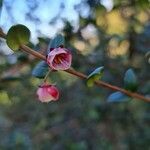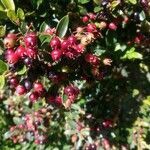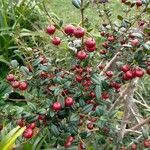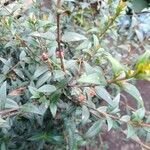Aromatic bushy shrub, 1-2 m high, often suckering profusely. Shoots often reddish when young, later deep brown, densely clothed in short hairs at first. Petiole < 6 mm long, hairy. Lamina 0.7-3.4 × 0.6-2.8 cm, longer and narrower on juvenile shoots, usually broad-ovate to suborbicular, sometimes ovate to elliptic, coriaceous, pale below, dark shining green above, recurved at margins; glabrous except for midrib beneath at first; base rounded to subcordate; apex acute to obtuse. Pedicels 1-1.5 cm long, hairy or nearly glabrous, slender, curved downwards. Bracteoles 3-4.3 mm long, linear-lanceolate. Fls pendent. Calyx lobes 3-4 mm long, lanceolate to ± triangular. Petals 5-7 mm long, pale pink, imbricate, concave, forming a campanulate corolla. Stamens unequal, < style and petals. Fr. 8-14 mm diam., almost globular, rose, becoming dark purplish red; flesh white, sweet.
More
A small evergreen shrub. It grows up to 1-1.8 m tall. It spreads 0.9 m wide. The stems are wiry. They are red. The leaves are deep green and glossy. The flowers are urn shaped. The flowers are cream with pink tints. There are 40-60 tiny stamen at the centre. The fruit is similar to cranberry. The fruit are rich red and round. They are 2-3 cm across.
It is a temperate plant. It will grow in most soils. It is tolerant of moderate frosts. It needs acid soil. It cannot tolerate lime. They do best in cool, moist, humus-rich soils. The soils need to be well-drained. They can grow in sun or part shade. In Argentina it grows between 700-1,500 m above sea level. It suits hardiness zones 8-10. Hobart Botanical Gardens. Arboretum Tasmania.
More
Woodland edges and scrub.
The fruit are used for jellies, jam, sauce, drinks and wine. They can be eaten raw. The leaves are used to flavour water. The seeds are used as a coffee substitute.
